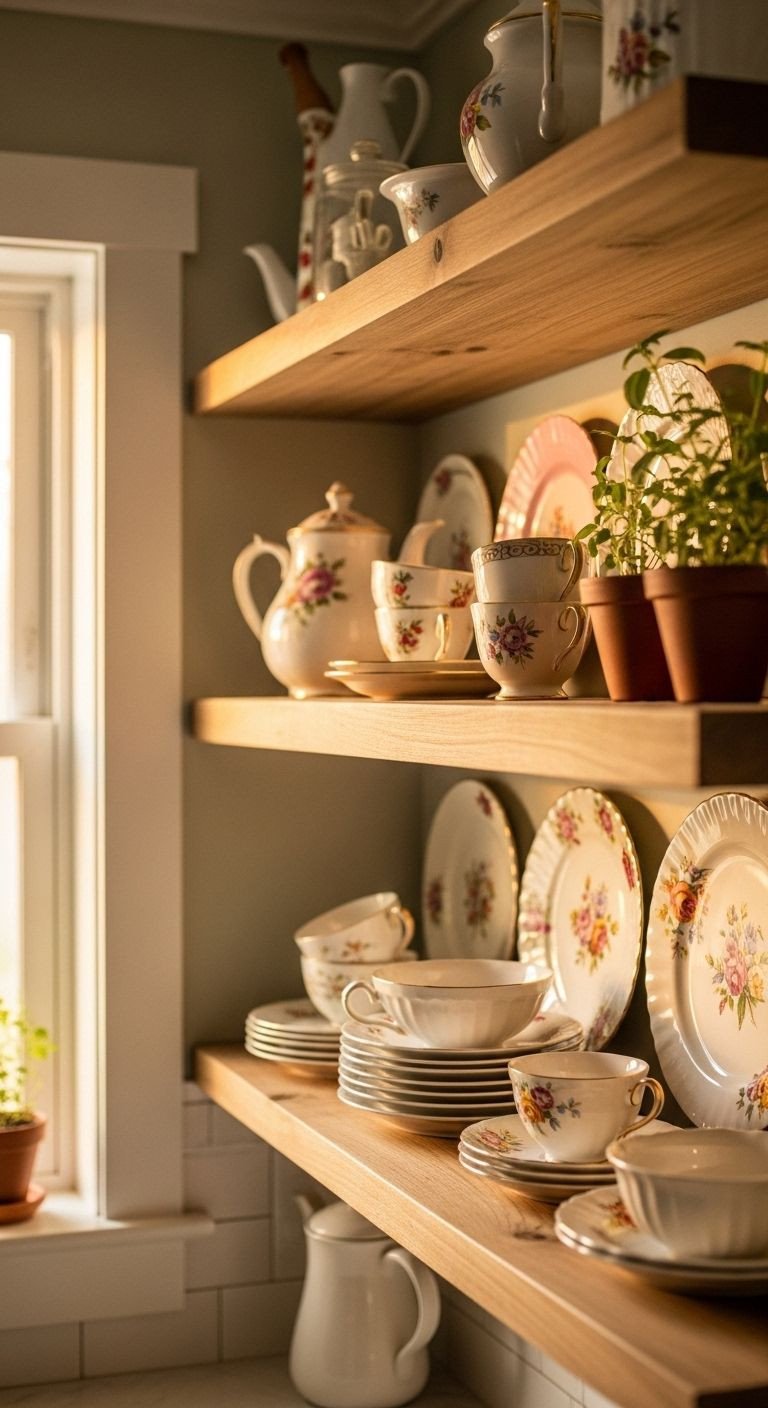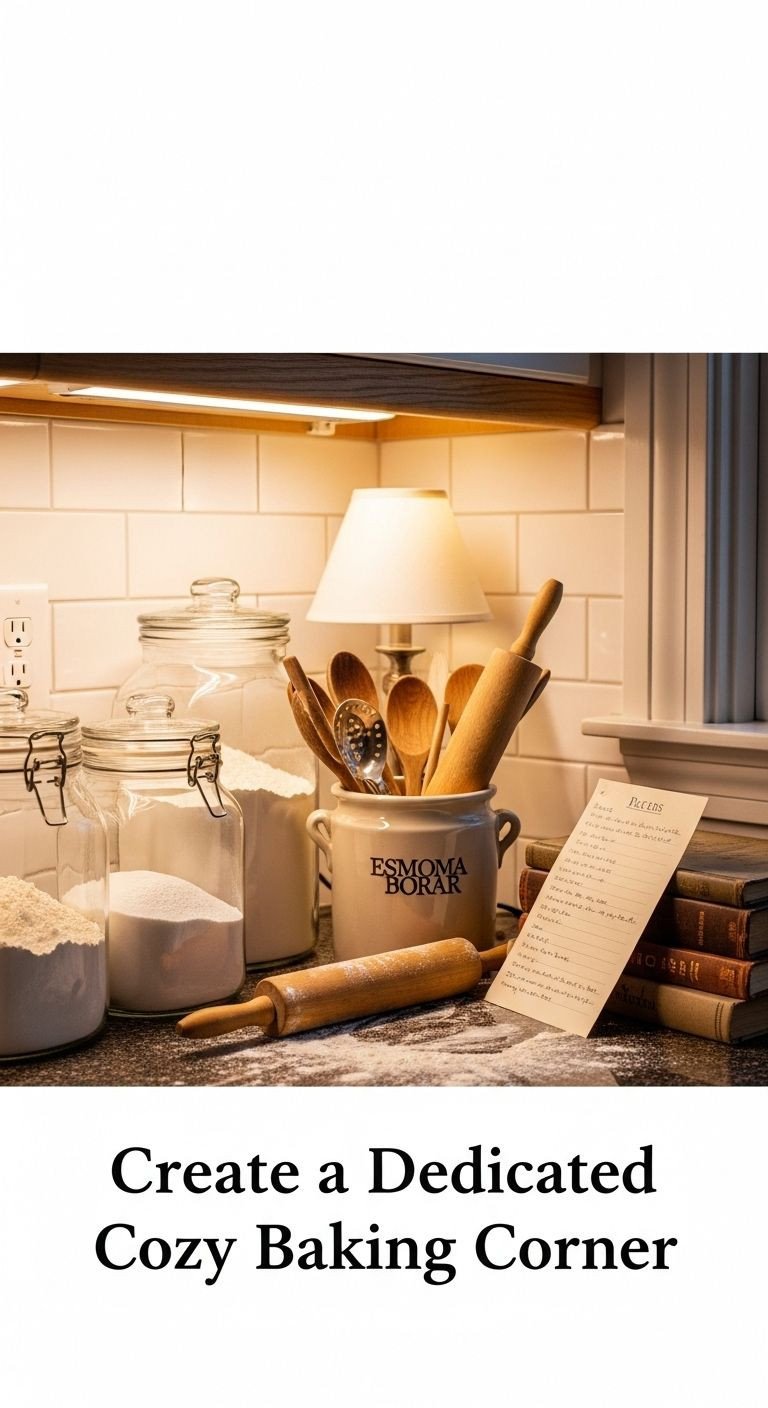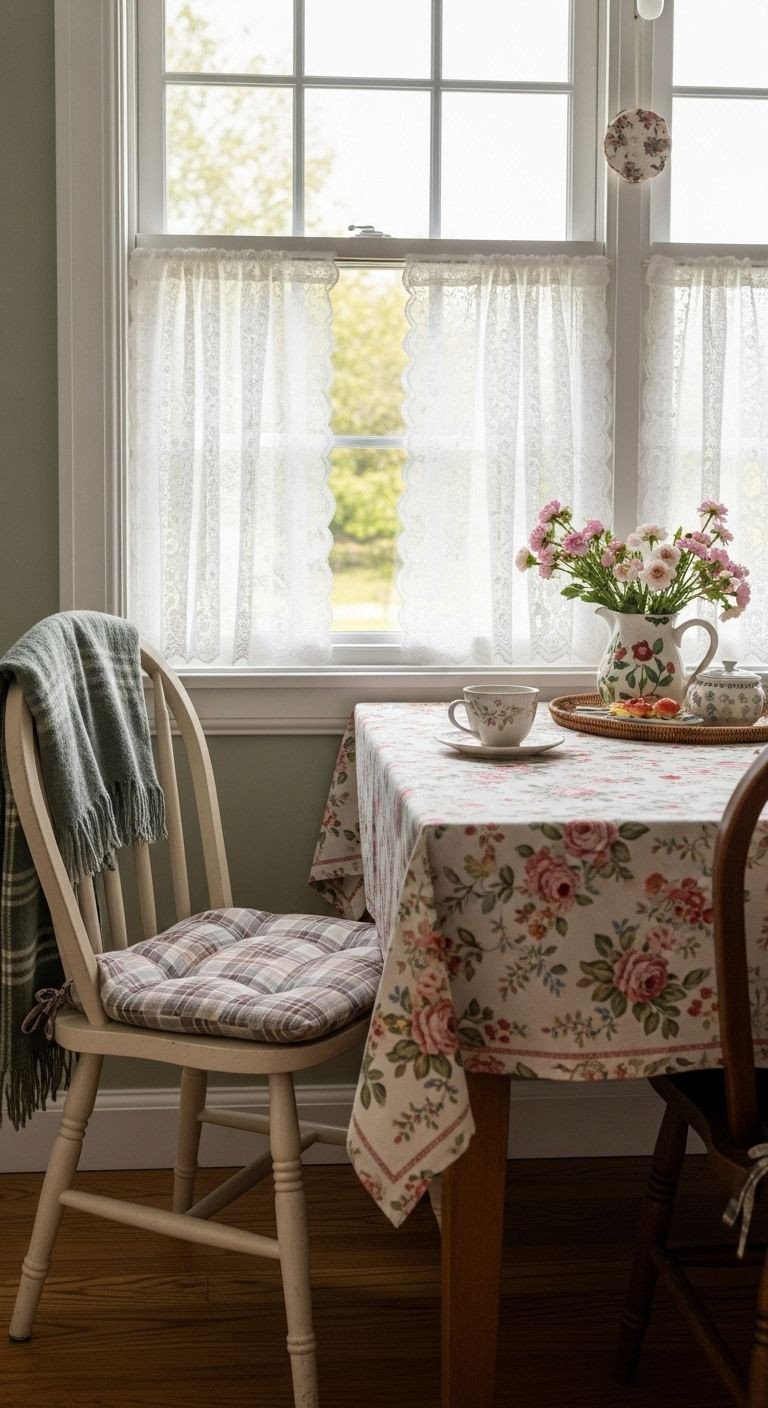As an Amazon Associate KitchenwareSets.com earns from qualifying purchases.
Cozy Grandmacore Kitchen Ideas That Feel Like Home
Have you ever walked into a kitchen and been instantly wrapped in a feeling of warmth, comfort, and nostalgia? It’s that “warm hug” feeling, a sense of home that smells faintly of freshly baked cookies and simmering soup, a space where every object seems to have a story. It’s the kitchen many of us remember from our grandmothers’ homes.
In a world dominated by sleek, minimalist designs and cool, impersonal surfaces, there’s a growing desire to reclaim that sense of lived-in comfort. You might be tired of a kitchen that feels more like a sterile laboratory than the heart of your home. You’re looking for character, personality, and a space that encourages you to slow down, create, and connect.
The solution is embracing the grandmacore kitchen aesthetic, a design trend that blends vintage charm with modern functionality to create a warm, nostalgic, and deeply personal space. It’s about curating a kitchen that feels collected over time, filled with love, and ready for making new memories. This guide will walk you through exactly what grandmacore is and provide actionable ideas to help you create your own cozy haven.
What is a Grandmacore Kitchen (and Why Does it Feel So Comforting)?
A grandmacore kitchen is an interior design style that blends the nostalgic charm of a grandmother’s home with the practical needs of modern living. This aesthetic rejects sterile minimalism in favor of warmth, eclectic collections, and a comforting, “lived-in” atmosphere. At its core, it’s about creating a space that feels like a warm hug, prioritizing personal touches and sentimental value over fleeting trends. It shares roots with cottagecore through its love for the handmade and rustic, but grandmacore is more specifically focused on the personal history and domestic comfort associated with a grandparent’s home.
The reason this style feels so universally comforting is rooted in psychology. It taps into positive, formative memories of safety, care, and abundance that many associate with their grandparents. The mix of soft textures, familiar patterns, and functional clutter (like a jar of wooden spoons on the counter) signals a space that is used, loved, and meant for nourishment—both for the body and the soul. It’s an intentional choice to surround yourself with objects and aesthetics that evoke happiness and a sense of belonging.
The Key Ingredients: Core Characteristics of Grandmacore
The core characteristics of a grandmacore kitchen are the specific elements that work together to create its signature nostalgic and cozy feel. These include a soft, warm color palette, natural materials, an abundance of texture, and decor that tells a personal story.
Here are the key ingredients broken down:
- Color Palette: The foundation is typically warm and inviting. Think of soft, muted colors like butter yellow, sage green, creamy off-white, and dusty blues or pinks. These colors are calming and provide a perfect backdrop for more vibrant, patterned decor.
- Materials & Textures: Natural materials are essential. You’ll see lots of natural wood in cabinets, flooring, or butcher block countertops. This is layered with an abundance of soft textures like lace cafe curtains, embroidered tea towels, floral or plaid tablecloths, and crocheted doilies.
- Cabinetry & Storage: Open shelving or glass-front cabinets are a hallmark of the style. They are used not just for storage but as a primary decorative feature, providing the perfect stage to display collections of vintage dishware. Traditional shaker-style or beadboard cabinets also fit perfectly.
- Appliances & Fixtures: While modern stainless steel appliances can certainly be integrated, the ideal grandmacore kitchen might feature retro-style appliances in pastel hues. For fixtures, think of brass, copper, or oil-rubbed bronze hardware and faucets, which add a warm, aged patina.
- Decor & Accessories: This is where the personality shines. Decor is eclectic and collected, featuring vintage floral china, antique Pyrex, mismatched teacups, handwritten recipe cards on display, potted herbs on the windowsill, and framed family photos. It’s about showcasing items with sentimental value.
10 Cozy Grandmacore Kitchen Ideas to Create Your Nostalgic Haven
Ready to infuse your kitchen with that signature grandmacore warmth? You don’t need a complete overhaul to get started. The magic of this style lies in the layers and personal touches you add over time.
Here are 10 cozy and achievable grandmacore kitchen ideas that will help you transform your space into a nostalgic, welcoming haven. Each idea focuses on adding character, texture, and a sense of history, turning your kitchen into the true heart of your home.
1. Curate a Vintage Dishware Display on Open Shelves

One of the most impactful ways to get the look is to showcase a curated collection of vintage plates, teacups, and bowls on open shelving. This turns everyday items into a beautiful, evolving art display that is packed with personality.
Materials Needed:
* Floating wooden shelves or a freestanding hutch
* Assorted vintage plates, teacups, and bowls
* Small plate stands
* Picture hanging strips (for wall-mounted plates)
* Measuring tape, level, and drill
Step-by-Step Directions:
- Source Your Treasures: The hunt is part of the fun! Spend a weekend visiting local thrift stores, flea markets, and estate sales. Look for unique pieces with floral patterns, gold rims, or interesting designs. Don’t worry about finding matching sets—an eclectic, mismatched collection is the goal.
- Clean and Prep: Gently hand-wash all your vintage finds. Before you commit to drilling holes, lay out your planned arrangement on the floor or a large table to get a feel for the spacing and balance.
- Arrange by Visual Weight: Place larger, heavier-looking items like serving platters or mixing bowls on the bottom shelves to anchor the display. Use clear plastic or brass plate stands to prop up your most decorative plates towards the back of the shelf.
- Stack and Layer: Create visual interest by making small stacks of bowls or saucers. You can then place a delicate teacup in front of the stack or right on top of it.
- Mix in Other Objects: To prevent the display from looking like a retail store, intersperse your dishware with other charming objects. Small potted plants (like succulents or herbs), vintage tins, a small stack of old cookbooks, or tiny framed photos will add depth and a personal touch.
Pro-Tip: In my own experience, displaying vintage dishes can be nerve-wracking. To prevent chipping and add an extra layer of authentic granny-chic texture, place a small piece of felt or a delicate paper doily between stacked plates or bowls. It’s a small detail that makes a big difference.
Save this beautiful shelving idea to your ‘Cozy Kitchen’ board!
2. Create a Dedicated Cozy Baking Corner

A key element of grandmacore is the celebration of homemade goods, which means you should designate a specific spot in your kitchen as a functional and beautiful baking station. This corner invites you to slow down and enjoy the process of creating something from scratch.
Materials Needed:
* A small section of countertop or a small freestanding wooden table/cart
* Large glass canisters with lids (wood or ceramic lids are a great touch)
* A collection of vintage tins
* A large ceramic crock or vintage pitcher
* A small stand for a cookbook or recipe card
* Assorted baking tools (wooden spoons, whisks, rolling pin)
Step-by-Step Directions:
- Designate Your Space: You don’t need a huge area. Clear off a corner of your countertop or, if you’re short on space, bring in a small wooden cart on wheels. This creates a defined “zone” for all your baking activities.
- Decant Your Staples: This is a game-changer for both function and form. Transfer flour, sugar, oats, and brown sugar into large, clear glass canisters. Seeing the ingredients is not only practical but adds a beautiful, rustic, old-world apothecary vibe.
- Corral Your Tools: Instead of hiding them in a drawer, gather your most-used baking utensils. Place wooden spoons, spatulas, whisks, and a classic rolling pin into a large ceramic crock or a charming vintage pitcher. This keeps them within arm’s reach and doubles as decor.
- Display with Charm: Use smaller vintage tins to store items that don’t need to be airtight, like cookie cutters, baking soda, or sprinkles. The worn-in look of old tins adds instant history.
- Add the Final Touch: The soul of a baking corner is in the recipes. Prop open a beloved, food-stained vintage cookbook on a small stand. Even better, frame a handwritten recipe card from your grandmother or mother and lean it against the wall.
Lesson Learned: One thing I learned the hard way was the importance of labeling! I once mixed up the salt and sugar because my canisters looked identical. Use charming, rustic-looking labels or a simple paint pen to write directly on the glass. It looks cute and prevents any baking disasters.
Pin this cozy baking corner for your future dream kitchen!
3. Layer with Nostalgic Textiles and Patterns

To instantly add softness, color, and a sense of history, you should layer your kitchen with a mix of nostalgic textiles and patterns. Hard surfaces like countertops and cabinets will immediately feel warmer and more inviting when balanced with soft fabrics.
Materials Needed:
* Lace, sheer, or floral cafe curtains
* A vintage-style floral or plaid tablecloth
* Assorted cushions for chairs or a breakfast nook bench
* Embroidered or patterned tea towels
* Vintage lace or crocheted doilies
Step-by-Step Directions:
- Soften the Windows: Ditch the heavy blinds. Install simple cafe curtains on the lower half of your kitchen window. Look for delicate lace, a sheer floral fabric, or a simple gingham pattern. This approach allows plenty of natural light to stream in while still providing a soft, decorative touch.
- Dress the Table: A bare kitchen table can feel cold. Drape a vintage-style tablecloth over it, even when it’s not mealtime. A classic floral print or a cheerful plaid adds instant color and pattern, making the kitchen feel more “dressed” and complete.
- Add Cushioned Comfort: Make your kitchen seating cozier by placing comfortable cushions on dining chairs or a window seat. This is the perfect opportunity to practice the art of pattern mixing. Don’t be afraid to pair a floral cushion with a simple striped one if they share a common color.
- Display Functional Fabrics: The prettiest items in a grandmacore kitchen are often the most useful. Instead of plain dish towels, seek out beautifully embroidered or patterned tea towels and drape them over your oven handle or by the sink.
- Incorporate Delicate Details: For the final, quintessential granny-chic touch, incorporate lace doilies. Place one under a fruit bowl on the counter, beneath a vase of flowers on the table, or on an open shelf. It’s a small detail that speaks volumes about the style.
Pro-Tip: The key to successfully mixing patterns is to stick to a cohesive color palette. For example, if your tablecloth is a busy blue and white floral, choose plaid or striped cushions that also feature shades of blue and white. This creates a look that is eclectic and layered, not chaotic.
Love these cozy textures? Save this idea for later!
Key Takeaways: Your Quick Guide to a Grandmacore Kitchen
Creating a grandmacore kitchen is a journey, not a destination. It’s about slowly curating a space that reflects your history and brings you comfort. Here are the core principles to remember:
- Embrace the Imperfect: Prioritize secondhand and vintage finds from thrift stores, flea markets, and antique shops. A collected, eclectic look built over time is far more authentic and charming than a perfectly matched, brand-new set.
- Layer Textures & Patterns: The secret to coziness is layering. Mix floral fabrics, cheerful plaids, delicate lace, and embroidered details to create a space that feels warm, deep, and visually interesting.
- Display with Love: Your kitchen should tell your story. Use open shelving and glass-front cabinets to showcase personal collections, from floral china passed down through your family to quirky vintage kitchenware you’ve discovered.
- Prioritize Warmth: Banish harsh, cold lighting. Use soft, warm light from multiple sources like vintage-style pendants, small table lamps on the counter, and under-cabinet lighting. Pair this with a color palette of muted tones like butter yellow, sage green, and creamy whites.
- Add Life: Nothing makes a space feel more alive than nature. Bring in natural elements like potted herbs on the windowsill, a vase of fresh-cut flowers on the table, and a large bowl of fresh fruit or vegetables on the counter.
People Also Ask About Grandmacore Kitchens
What is the difference between Grandmacore and Cottagecore?
The primary difference is focus and scope; while similar, Grandmacore focuses specifically on nostalgia, comfort, and items you’d find in a grandmother’s home (e.g., vintage Pyrex, handwritten recipes, family photos). Cottagecore romanticizes a broader rural or farm life, emphasizing elements like rustic wood, foraging, and a deep connection to nature. A grandmacore kitchen can be a key component within a larger cottagecore-themed home, but it has a more personal, domestic, and sentimental focus.
Can I create a Grandmacore kitchen on a budget?
Absolutely! Grandmacore is one of the most budget-friendly aesthetics because it thrives on secondhand and imperfect finds. You can achieve the look very affordably by frequenting thrift stores, flea markets, and estate sales to find unique furniture, dishware, and decor for a fraction of the price of new items. Furthermore, DIY projects are at the heart of the style—painting your existing cabinets a soft pastel color, sewing your own cafe curtains, or framing old family recipes are all great ways to save money while adding an invaluable personal touch.
Do I need vintage appliances to have a Grandmacore kitchen?
No, you do not need vintage or vintage-style appliances to create a beautiful grandmacore kitchen. While retro appliances are a lovely touch, they aren’t a necessity. You can easily integrate your existing modern stainless steel or white appliances. The key is to surround them with the core elements of the grandmacore style—warm paint colors, vintage decor on open shelves, soft textiles, and warm wood tones. These elements will soften the modern look of the appliances and help them blend seamlessly into the overall cozy and nostalgic aesthetic.
Final Thoughts
Ultimately, creating a grandmacore kitchen is less about following a strict set of rules and more about listening to your heart. It’s an invitation to curate a space that feels authentically personal, endlessly comfortable, and full of love. It’s about celebrating the beauty in the everyday, the history in the secondhand, and the joy in the handmade.
Don’t feel pressured to achieve the look overnight. Start small. Begin with a single piece of floral china that catches your eye at a thrift store, or simply place a small pot of basil on your windowsill. Let your cozy haven grow organically, piece by piece, story by story. Before you know it, you’ll have created a kitchen that not only looks beautiful but feels like home.
What’s the one item from your own grandmother’s kitchen that you’d love to include in your home?
